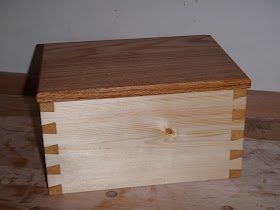After attempting my first dovetails around November last year, I haven't built upon the experience or attempted any other dovetails since. The Small Pine Chest was (and still is) my favourite project so far and I think I got very lucky with some quite tidy joints for a beginner.
I decided it was time to attempt to repeat the experience, almost knowing ahead of time that the first time was a fluke, and so to prepare for disappointment.
The idea for this project came from a small piece of Oak I had which was an offcut from the first ever thing I made. I decided it would make a nice lid for a box, and this with a length of 6" wide Pine board formed my stock.
I wont bore you too much with the starting process, needless to say that the bench hook, tenon saw and square, chisel and knife saw to cutting the pine to length, before using my no#4 plane and shooting board to shoot the ends clean.
Having all my components to size, I started to get a feel for the finished box.
After cutting to length I noticed a slight cupping of the boards and so dealt with this by planing across and diagonal to the grain with both my no#6 and no#4 .
Time to get my tools sorted for dovetails....
I used my new Veritas 1:6 dovetail template to make short work of marking out the tails, doing two boards at a time. It's certainly more accurate and less fiddly than using a bevel gauge. Time for some chopping...
After a quick sharpening session, I decided to remove all the tail waste using only chisels. Previously I think I removed the bulk of the waste using a fret saw. Once complete I marked out the bespoke Pins one board at a time using the side of my no#4 plane to mate up the boards accurately.
Maybe as a result of watching to many Utube dovetail videos, I tried to make the effort to not be overly slow and meticulous about making this box. I certainly didn't fuss to much with cutting the tails knowing the pins are marked from the tails and should correct any innacuracies. Obviously you get faster and better with time, but I don't want to spend a week making a simple box.
Ok .. first dry fit... not as good as they should be cosmetically but it's certainly a strong box! Lesson learn't my board ends are slightly off square and hence my baselines are different either side of the board when marked out with the marking gauge. It's not a lot but enough to create gappy joinery. On with the show...
I thought it was about time I did my first ever grooved bottom and do the box bottom properly.
Ta daaa....The debut of my new Record 44 Plough plane. After sharpening the 3/16ths blade and a quick practice with a small scrap of pine, I went for it. The groove was cut to (just over) 5mm deep, meaning I had to allow 1cm in length and width when cutting the bottom piece. I decided to put the grooves all the way through the pins and later hide the resultant holes with a skirt.
Time to cut some thin plywood for the bottom... 25cm x 17.5cm.
And do a dry fit....
The box holds together really tightly, it could probably serve it's purpose without glue.... I hate this bit!
Panic over - I managed to get it all together with a lot of banging with a leather faced mallet and a scrap of wood. Unfortunately, the sight of the joinery closing up nicely with the added gap filler of glue led to me applying slight too much pressure....Doh!
Not to worry - it's not the end of the world and I can probably doctor those small cracks when the glue is dry. The next step was to plane the old varnish from the box lid, trim it to size and add a decorative small bevel.
With the box out of the clamps I used my Stanley 102 block plane to trim the proud pins and tails before smoothing with my no#4.
The clamps and glue had helped to close up the dovetails, still not perfect and the odd one was a little gappy, but overall I'm not too disappointed as a second attempt. In the true spirit of 'full disclosure', the following pictures show the pins and tails of all four sides.
Basically at this stage the box is almost complete and I had a change of mind (partly due to laziness) about fitting a skirt to hide the bottom groove in the bottom half pins. Instead I thought I would keep it simple, try and match the grain as best as I can and plug the holes.
I used a chisel to 'rive' off small pieces of pine and trim to fit before glueing them in and finally using my flush cut saw to trim them off. I think they look fine.
So aside from having any hinges (which I'll fit at a later date) and a coat or two of Boiled Linseed Oil (BLO), I was done. All in all I am quite pleased with this project both in terms of how it turned out and the time it took me to do it. Being only my second attempt at dovetails and my first ever grooved bottom made it interesting from start to finish without it becoming too epic.















































